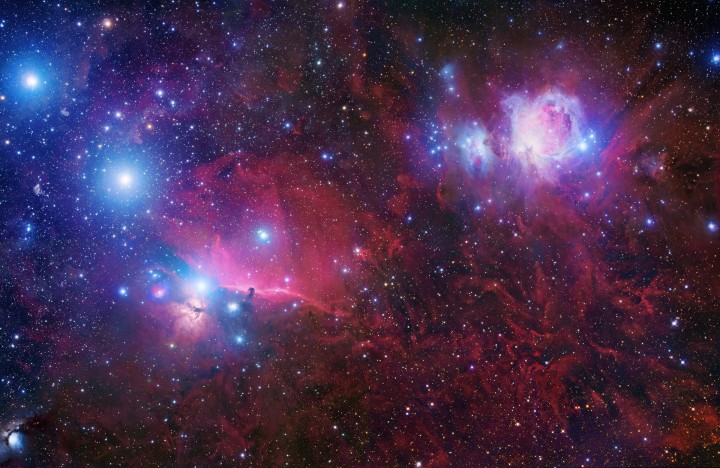Credit & Copyright: Robert Gendler
Explanation:
Adrift 1,500 light-years away in one of
the night sky's most recognizable
constellations, the glowing
Orion Nebula and the dark
Horsehead Nebula are contrasting
cosmic vistas.
But even fainter filaments of glowing gas are easily traced
throughout the region in
this
stunning composite image
that includes exposures filtered to record emission
from hydrogen atoms.
The view reveals extensive
nebulosities associated with
the giant Orion Molecular
Cloud
complex, itself hundreds of light-years across.
A magnificent emission region, the
Orion
Nebula (aka M42) lies at the
upper right of the picture.
Immediately to its left are a cluster of prominent bluish
reflection nebulae sometimes called
the Running Man.
The Horsehead
nebula appears as a dark cloud, a small silhouette
notched against the long red glow left of center.
Alnitak is the easternmost star in Orion's belt and
the brightest star to the left of the Horsehead.
Below Alnitak is the
Flame Nebula, with clouds of
bright emission and dramatic dark dust lanes.
Completing the trio of Orion's belt
stars, bluish Alnilam and Mintaka form a line with Alnitak,
extending to the upper left.
1999 2000 2001 2002 2003 2004 2005 2006 2007 2008 2009 2010 2011 2012 2013 2014 2015 2016 2017 2018 2019 2020 2021 2022 2023 2024 2025 |
Yanvar' Fevral' Mart Aprel' Mai Iyun' Iyul' Avgust Sentyabr' Oktyabr' Noyabr' Dekabr' |
NASA Web Site Statements, Warnings, and Disclaimers
NASA Official: Jay Norris. Specific rights apply.
A service of: LHEA at NASA / GSFC
& Michigan Tech. U.
|
Publikacii s klyuchevymi slovami:
tumannost' Konskaya Golova - Tumannost' Oriona
Publikacii so slovami: tumannost' Konskaya Golova - Tumannost' Oriona | |
Sm. takzhe:
Vse publikacii na tu zhe temu >> | |
